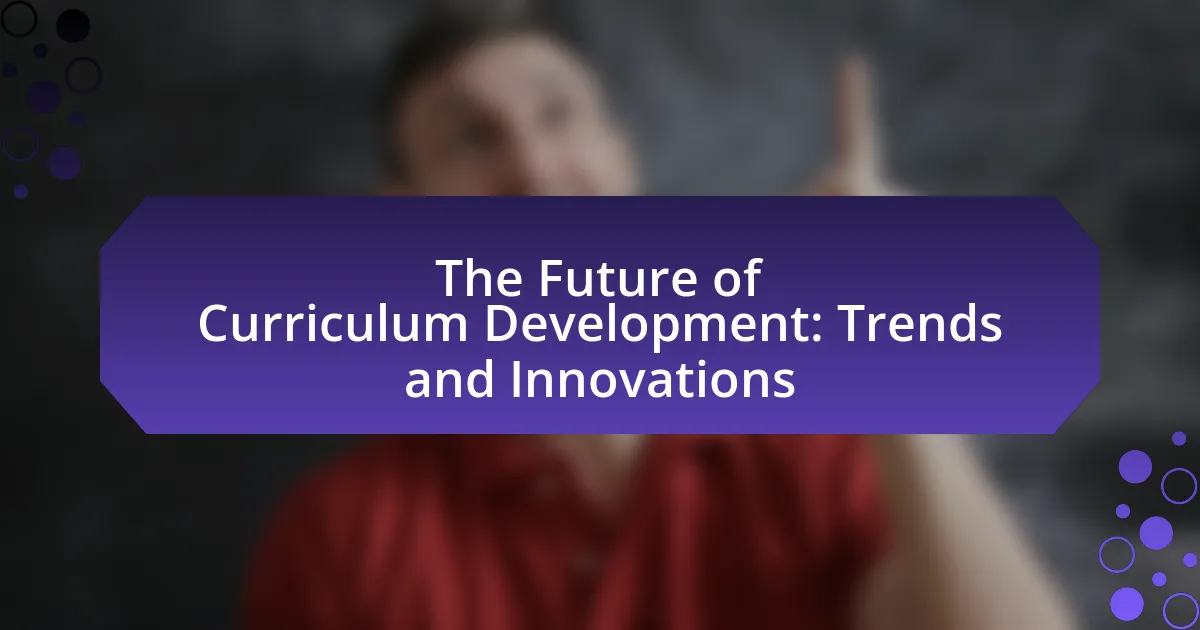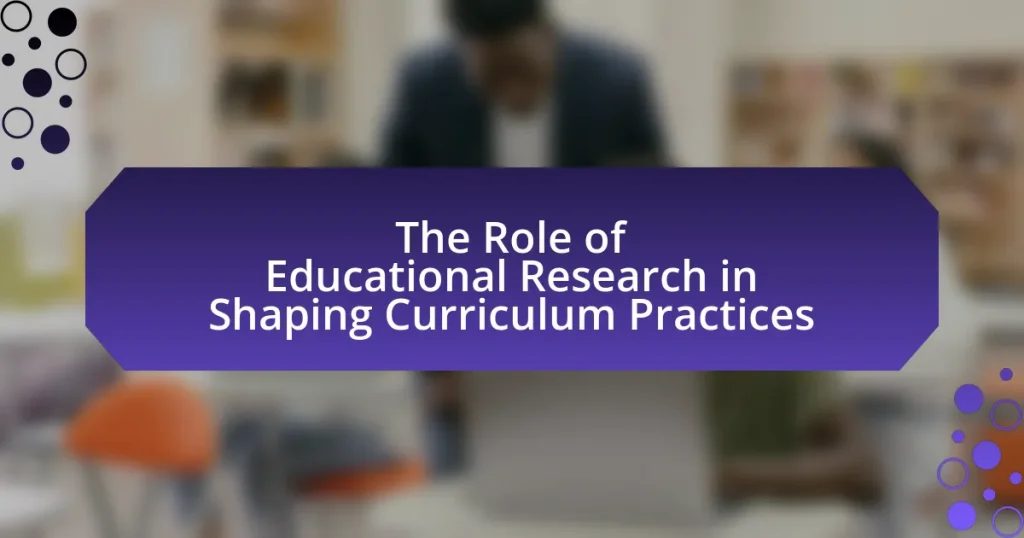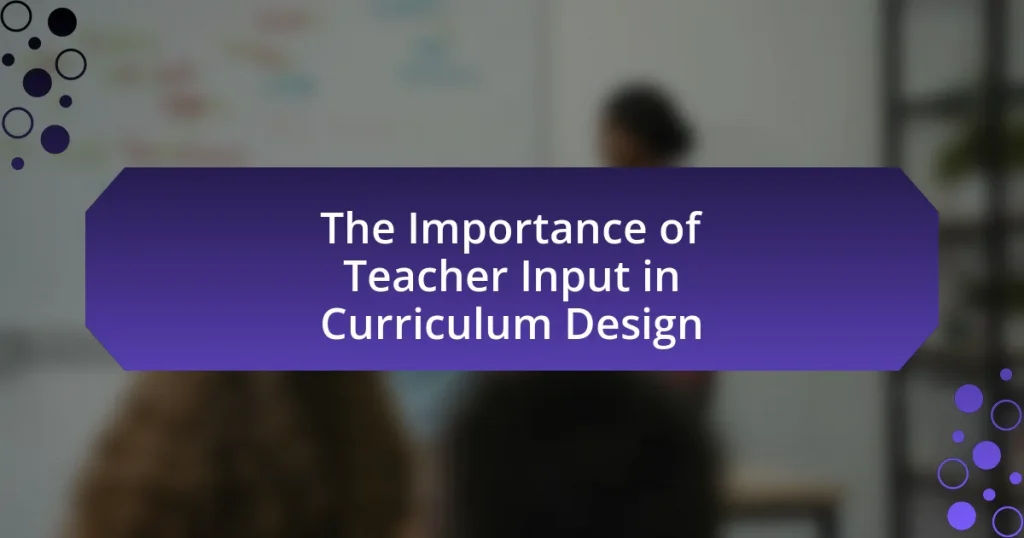The article focuses on the future of curriculum development, highlighting current trends and innovations shaping educational practices. Key topics include personalized learning, technology integration, social-emotional learning, and competency-based education, which collectively aim to enhance student engagement and achievement. The article also explores the impact of artificial intelligence, virtual and augmented reality, and interdisciplinary approaches on curriculum design. Additionally, it addresses the importance of inclusivity, equity in educational resources, and the role of data analytics in improving curriculum effectiveness. Overall, the content provides a comprehensive overview of how modern educational frameworks are evolving to meet the diverse needs of learners in a rapidly changing world.
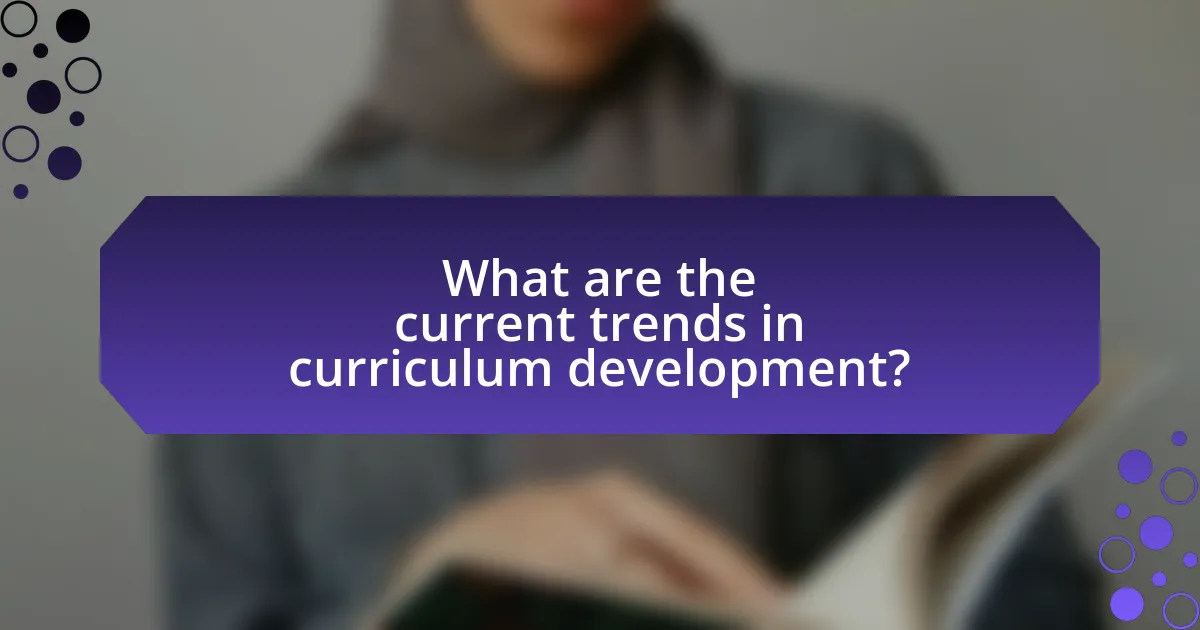
What are the current trends in curriculum development?
Current trends in curriculum development include a focus on personalized learning, integration of technology, and emphasis on social-emotional learning. Personalized learning tailors educational experiences to individual student needs, allowing for differentiated instruction that enhances engagement and achievement. The integration of technology, such as online resources and digital tools, facilitates interactive learning environments and prepares students for a tech-driven world. Additionally, social-emotional learning is increasingly recognized as essential for fostering students’ emotional intelligence and resilience, contributing to their overall well-being and academic success. These trends reflect a shift towards more holistic and adaptable educational frameworks that respond to the diverse needs of learners in contemporary society.
How are technological advancements influencing curriculum design?
Technological advancements are significantly influencing curriculum design by enabling personalized learning experiences and integrating digital tools into educational frameworks. These advancements allow educators to tailor content to individual student needs, fostering engagement and improving learning outcomes. For instance, adaptive learning technologies, such as intelligent tutoring systems, adjust the difficulty of tasks based on real-time student performance data, which has been shown to enhance mastery of subjects. Additionally, the incorporation of multimedia resources, such as interactive simulations and online collaboration platforms, enriches the learning environment, making complex concepts more accessible. Research indicates that schools utilizing technology in curriculum design report higher student motivation and achievement, demonstrating the effectiveness of these innovations in modern education.
What role does artificial intelligence play in personalized learning?
Artificial intelligence plays a crucial role in personalized learning by enabling adaptive learning experiences tailored to individual student needs. AI systems analyze data on student performance, learning styles, and preferences to customize educational content and pacing. For instance, platforms like DreamBox Learning and Knewton utilize algorithms to adjust lessons in real-time based on student interactions, enhancing engagement and effectiveness. Research indicates that personalized learning approaches, supported by AI, can lead to improved academic outcomes, with studies showing a 30% increase in student performance in subjects like mathematics when using AI-driven tools.
How can virtual and augmented reality enhance educational experiences?
Virtual and augmented reality can enhance educational experiences by providing immersive and interactive learning environments that engage students more effectively than traditional methods. These technologies allow learners to visualize complex concepts, such as anatomy or physics, in a three-dimensional space, facilitating deeper understanding. For instance, a study published in the Journal of Educational Technology & Society found that students using virtual reality for anatomy lessons scored 20% higher on assessments compared to those using standard textbooks. This demonstrates that immersive experiences can lead to improved retention and comprehension of educational material.
What shifts are occurring in educational pedagogy?
Shifts in educational pedagogy include a move towards student-centered learning, increased integration of technology, and a focus on critical thinking and collaboration. These changes reflect a growing recognition of diverse learning styles and the need for skills relevant to the 21st century workforce. For instance, the use of blended learning models combines traditional teaching with online resources, enhancing accessibility and engagement. Research by the Bill & Melinda Gates Foundation indicates that personalized learning approaches can significantly improve student outcomes, demonstrating the effectiveness of these pedagogical shifts.
How is competency-based education changing traditional learning models?
Competency-based education (CBE) is transforming traditional learning models by emphasizing mastery of skills and knowledge over time spent in class. This shift allows learners to progress at their own pace, ensuring they fully understand a subject before moving on, which contrasts with the fixed timelines of traditional education. Research indicates that CBE can lead to improved student engagement and retention rates, as students are more motivated when they see tangible progress in their learning. For instance, a study by the Bill & Melinda Gates Foundation found that institutions implementing CBE reported higher completion rates compared to those using conventional methods. This approach not only personalizes learning but also aligns educational outcomes with workforce demands, making graduates more job-ready.
What is the impact of project-based learning on student engagement?
Project-based learning significantly enhances student engagement by fostering active participation and collaboration among learners. This instructional approach encourages students to take ownership of their learning through hands-on projects that relate to real-world problems. Research conducted by Thomas Markham in “Project Based Learning: A Bridge Just Far Enough” indicates that students involved in project-based learning demonstrate higher levels of motivation and interest in their studies compared to traditional learning methods. Additionally, a study published in the “Journal of Educational Psychology” found that students engaged in project-based learning showed improved critical thinking skills and a deeper understanding of the subject matter, further reinforcing the positive impact on engagement.
Why is inclusivity becoming a priority in curriculum development?
Inclusivity is becoming a priority in curriculum development to ensure equitable access to education for all students, regardless of their backgrounds or abilities. This shift is driven by the recognition that diverse learning needs enhance educational outcomes and foster a more inclusive society. Research indicates that inclusive curricula can improve student engagement and achievement; for instance, a study by the National Center for Learning Disabilities found that inclusive practices lead to higher academic performance among students with disabilities. Furthermore, inclusive education promotes social cohesion and prepares students for a diverse workforce, aligning with global educational goals such as the United Nations Sustainable Development Goal 4, which emphasizes inclusive and equitable quality education.
How can curricula be designed to accommodate diverse learning needs?
Curricula can be designed to accommodate diverse learning needs by incorporating differentiated instruction, flexible assessment methods, and culturally relevant materials. Differentiated instruction allows educators to tailor lessons to various learning styles and abilities, ensuring that all students can engage with the content effectively. Flexible assessment methods, such as project-based assessments and formative evaluations, provide multiple avenues for students to demonstrate their understanding, catering to individual strengths. Culturally relevant materials ensure that the curriculum reflects the diverse backgrounds of students, promoting inclusivity and engagement. Research indicates that these strategies lead to improved academic outcomes and increased student motivation, as evidenced by studies showing that differentiated instruction can enhance learning for students with varying abilities (Tomlinson, 2001).
What strategies promote equity in educational resources?
Strategies that promote equity in educational resources include targeted funding, inclusive curriculum design, and community engagement. Targeted funding ensures that under-resourced schools receive additional financial support, which can be evidenced by programs like Title I in the United States, which allocates federal funds to schools with high percentages of low-income students. Inclusive curriculum design involves creating materials that reflect diverse cultures and perspectives, thereby fostering a sense of belonging among all students. Community engagement encourages partnerships between schools and local organizations to provide resources and support tailored to the specific needs of the community, as seen in initiatives like the Harlem Children’s Zone, which integrates education with community services. These strategies collectively work to bridge the resource gap and ensure equitable access to quality education for all students.
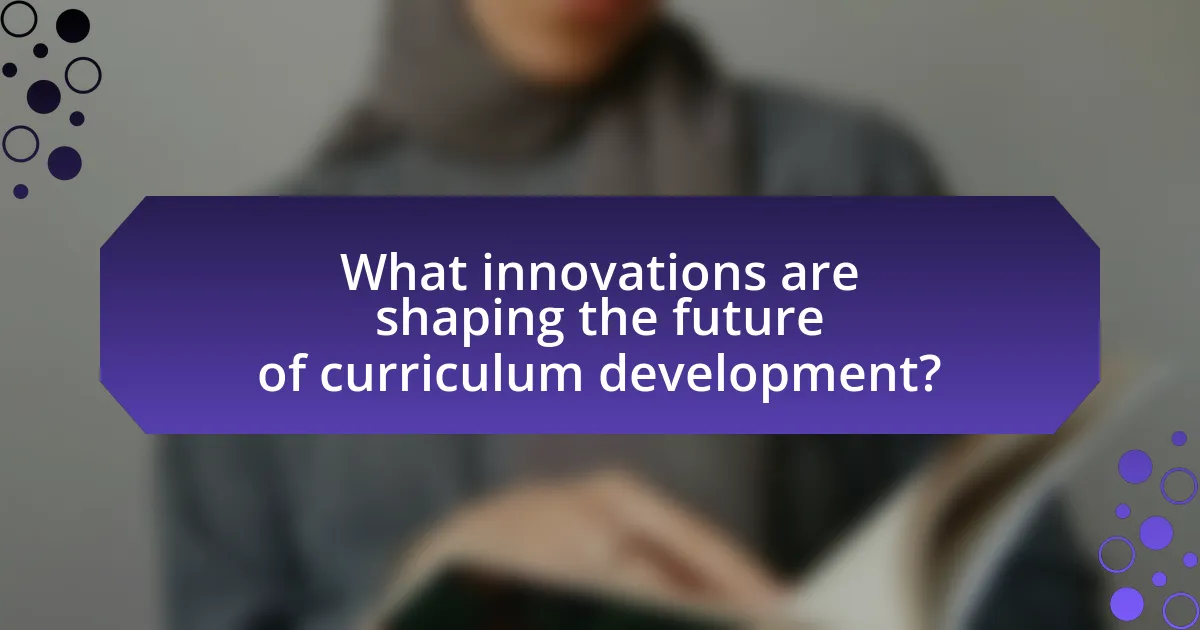
What innovations are shaping the future of curriculum development?
Innovations shaping the future of curriculum development include personalized learning, technology integration, and competency-based education. Personalized learning tailors educational experiences to individual student needs, enhancing engagement and effectiveness. Technology integration, such as the use of artificial intelligence and online platforms, facilitates access to diverse resources and fosters collaborative learning environments. Competency-based education focuses on students mastering skills at their own pace, ensuring a deeper understanding of the material. These innovations are supported by research indicating that personalized approaches can improve student outcomes, with studies showing a 30% increase in engagement when technology is effectively utilized in classrooms.
How are interdisciplinary approaches being integrated into curricula?
Interdisciplinary approaches are being integrated into curricula through collaborative projects, thematic units, and problem-based learning that connect multiple subjects. Educational institutions are increasingly designing courses that blend disciplines, such as combining science and art to explore environmental issues, which enhances critical thinking and creativity. Research indicates that schools implementing interdisciplinary curricula report improved student engagement and retention of knowledge, as evidenced by a study from the National Academy of Sciences, which found that students in integrated programs performed better on assessments compared to those in traditional, subject-specific classes.
What benefits do interdisciplinary studies offer to students?
Interdisciplinary studies offer students the benefit of a holistic understanding of complex issues by integrating knowledge from multiple disciplines. This approach enhances critical thinking and problem-solving skills, as students learn to analyze problems from various perspectives. Research indicates that students engaged in interdisciplinary studies demonstrate improved collaboration skills and creativity, which are essential in today’s workforce. For instance, a study published in the Journal of Educational Psychology found that interdisciplinary learning environments significantly boost student engagement and retention of information, leading to better academic outcomes.
How can educators effectively implement interdisciplinary teaching methods?
Educators can effectively implement interdisciplinary teaching methods by designing integrated curricula that connect multiple subjects around a central theme or project. This approach encourages collaboration among teachers from different disciplines, allowing them to create cohesive learning experiences that reflect real-world applications. For instance, a project on climate change can incorporate science, geography, and social studies, enabling students to explore the topic from various perspectives. Research indicates that interdisciplinary teaching enhances critical thinking and problem-solving skills, as evidenced by a study published in the Journal of Educational Psychology, which found that students engaged in interdisciplinary projects demonstrated higher levels of engagement and retention of knowledge compared to traditional teaching methods.
What role does data analytics play in curriculum improvement?
Data analytics plays a crucial role in curriculum improvement by providing insights into student performance and learning outcomes. By analyzing data from assessments, attendance, and engagement metrics, educators can identify strengths and weaknesses in the curriculum. For instance, a study by the Bill & Melinda Gates Foundation found that data-driven decision-making in education leads to improved student achievement, as it allows for targeted interventions and personalized learning experiences. This evidence demonstrates that leveraging data analytics effectively informs curriculum adjustments, ensuring that educational programs meet the evolving needs of students.
How can data-driven decision-making enhance educational outcomes?
Data-driven decision-making enhances educational outcomes by enabling educators to tailor instruction based on empirical evidence and student performance data. This approach allows for the identification of learning gaps and the implementation of targeted interventions, which can lead to improved student engagement and achievement. For instance, a study by the Bill & Melinda Gates Foundation found that schools utilizing data analytics to inform teaching strategies saw a 10% increase in student performance on standardized tests. By leveraging data, educators can make informed decisions that directly impact curriculum effectiveness and student success.
What tools are available for educators to analyze curriculum effectiveness?
Educators can utilize various tools to analyze curriculum effectiveness, including assessment software, learning management systems (LMS), and data analytics platforms. Assessment software, such as Formative and Edulastic, allows educators to create and analyze assessments that measure student understanding and curriculum alignment. Learning management systems like Canvas and Moodle provide insights into student engagement and performance metrics, enabling educators to evaluate how well the curriculum meets learning objectives. Data analytics platforms, such as Tableau and Power BI, facilitate the visualization of student performance data, helping educators identify trends and areas for improvement in the curriculum. These tools collectively support data-driven decision-making in curriculum development and refinement.
How is global collaboration influencing curriculum development?
Global collaboration is significantly influencing curriculum development by promoting the exchange of diverse educational practices and resources across borders. This collaboration allows educators to integrate global perspectives, ensuring that curricula are relevant to a multicultural and interconnected world. For instance, initiatives like the Global Education Coalition, formed by UNESCO, emphasize the importance of sharing best practices and resources to enhance educational quality worldwide. Such collaborations lead to the incorporation of international standards and competencies, preparing students for a global workforce. Additionally, research indicates that collaborative curriculum development can improve educational outcomes, as seen in studies highlighting the effectiveness of cross-border partnerships in enhancing teaching methodologies and learning experiences.
What are the benefits of cross-border educational partnerships?
Cross-border educational partnerships enhance academic collaboration and cultural exchange, leading to improved educational outcomes. These partnerships allow institutions to share resources, expertise, and best practices, which can result in innovative curriculum development. For instance, a study by the Institute of International Education found that students participating in international partnerships often demonstrate higher levels of critical thinking and problem-solving skills. Additionally, such collaborations can increase access to diverse perspectives and knowledge, enriching the learning experience for students and faculty alike.
How can technology facilitate global learning experiences?
Technology facilitates global learning experiences by enabling real-time communication and collaboration across geographical boundaries. Online platforms such as video conferencing tools and collaborative software allow students and educators from different countries to engage in joint projects, share resources, and participate in discussions, thereby enriching the learning process. For instance, a study by the International Society for Technology in Education found that 85% of educators believe technology enhances student engagement and collaboration in a global context. This demonstrates that technology not only connects learners but also fosters a diverse educational environment that transcends cultural barriers.

What challenges do educators face in curriculum development?
Educators face several challenges in curriculum development, including aligning curriculum with educational standards, integrating technology effectively, and addressing diverse student needs. The alignment with educational standards is crucial as it ensures that the curriculum meets state and national requirements, which can be complex and time-consuming to navigate. Effective technology integration is another challenge, as educators must select appropriate tools that enhance learning without overwhelming students or detracting from core content. Additionally, addressing diverse student needs requires educators to create inclusive curricula that accommodate varying learning styles, backgrounds, and abilities, which can complicate the development process. These challenges are supported by research indicating that curriculum alignment and inclusivity are critical for improving educational outcomes (National Education Association, 2020).
How can resistance to change be addressed in educational institutions?
Resistance to change in educational institutions can be addressed through effective communication, stakeholder involvement, and professional development. Educational leaders should communicate the rationale behind changes clearly, ensuring that all stakeholders understand the benefits and goals. Involving teachers, students, and parents in the decision-making process fosters a sense of ownership and reduces resistance. Additionally, providing ongoing professional development equips educators with the skills and knowledge necessary to adapt to new curricula or teaching methods. Research indicates that institutions that prioritize these strategies experience smoother transitions and greater acceptance of change, as evidenced by a study published in the “Journal of Educational Change,” which found that inclusive practices significantly enhance the implementation of innovative educational reforms.
What strategies can leaders use to foster a culture of innovation?
Leaders can foster a culture of innovation by encouraging open communication and collaboration among team members. This approach allows diverse ideas to surface and be evaluated, leading to creative solutions. For instance, organizations like Google implement “20% time,” where employees can spend a portion of their workweek on projects they are passionate about, resulting in successful innovations like Gmail and Google News. Additionally, leaders can provide resources and training that empower employees to experiment and take calculated risks, which is essential for innovation. Research from the Harvard Business Review indicates that companies with a strong culture of innovation see 30% higher revenue growth compared to their competitors, highlighting the effectiveness of these strategies.
How can professional development support curriculum adaptation?
Professional development can support curriculum adaptation by equipping educators with the necessary skills and knowledge to implement changes effectively. Training programs focused on innovative teaching strategies, assessment techniques, and technology integration enable teachers to modify curricula in response to diverse student needs and evolving educational standards. Research indicates that ongoing professional development leads to improved instructional practices, which directly enhances curriculum responsiveness. For instance, a study by Desimone (2009) in “Effective Professional Development” highlights that sustained professional development correlates with increased teacher efficacy and student achievement, thereby validating the role of professional development in facilitating curriculum adaptation.
What are the financial implications of implementing new curricula?
Implementing new curricula incurs significant financial implications, including costs for development, training, and resources. The development phase often requires investment in research and design, which can range from thousands to millions of dollars depending on the complexity and scope of the curriculum. Training educators to effectively deliver the new content also demands substantial financial resources, as professional development programs can cost between $1,000 to $3,000 per teacher. Additionally, new materials and technology may need to be purchased, further increasing expenses. For instance, a study by the RAND Corporation indicated that districts can spend up to $1.5 billion annually on curriculum-related expenses. These financial factors must be carefully considered to ensure sustainable implementation and long-term success of the new curricula.
How can schools budget for innovative curriculum initiatives?
Schools can budget for innovative curriculum initiatives by allocating funds specifically for research, development, and implementation of new educational programs. This involves conducting a needs assessment to identify areas for innovation, followed by prioritizing initiatives based on potential impact and alignment with educational goals. For instance, a study by the Bill & Melinda Gates Foundation found that schools that strategically invest in technology and teacher training see improved student outcomes, demonstrating the effectiveness of targeted budgeting. Additionally, schools can seek grants and partnerships with local businesses or educational organizations to supplement their budgets, ensuring a more robust financial foundation for innovative projects.
What funding opportunities exist for curriculum development projects?
Funding opportunities for curriculum development projects include government grants, private foundations, and educational institutions. The U.S. Department of Education offers various grant programs, such as the Innovative Approaches to Literacy program, which supports innovative literacy projects. Additionally, organizations like the Bill & Melinda Gates Foundation provide funding for educational initiatives aimed at improving curriculum and teaching methods. Furthermore, local and state education agencies often have specific grants available for curriculum development tailored to regional needs. These funding sources are essential for supporting innovative educational practices and enhancing learning outcomes.
What best practices can educators adopt for effective curriculum development?
Educators can adopt several best practices for effective curriculum development, including aligning curriculum with learning standards, incorporating diverse teaching methods, and engaging stakeholders in the process. Aligning curriculum with established learning standards ensures that educational goals are met and that students acquire necessary skills, as evidenced by the Common Core State Standards initiative, which has improved student performance in various states. Incorporating diverse teaching methods, such as project-based learning and technology integration, caters to different learning styles and enhances student engagement, supported by research from the Institute of Education Sciences showing that varied instructional strategies lead to better learning outcomes. Engaging stakeholders, including teachers, parents, and community members, fosters a collaborative environment that enriches curriculum relevance and effectiveness, as highlighted in studies by the National Education Association, which emphasize the importance of community involvement in educational success.
How can collaboration among educators enhance curriculum quality?
Collaboration among educators enhances curriculum quality by fostering diverse perspectives and expertise, leading to more comprehensive and effective educational programs. When educators work together, they can share best practices, align learning objectives, and integrate interdisciplinary approaches, which enriches the curriculum. Research indicates that collaborative teaching models, such as co-teaching, can improve student outcomes by providing tailored instruction that meets varied learning needs. For instance, a study published in the “Journal of Educational Psychology” found that schools implementing collaborative practices saw a 20% increase in student engagement and achievement. This evidence supports the notion that collaboration not only improves curriculum design but also positively impacts student learning experiences.
What resources are available for ongoing curriculum evaluation and improvement?
Resources available for ongoing curriculum evaluation and improvement include educational frameworks, assessment tools, and professional development programs. Educational frameworks such as the Understanding by Design (UbD) model provide structured approaches for curriculum planning and evaluation. Assessment tools like formative assessments and standardized tests help measure student learning and inform curriculum adjustments. Professional development programs, including workshops and online courses, equip educators with the skills to analyze and enhance curriculum effectiveness. These resources collectively support continuous improvement in educational practices, ensuring that curricula remain relevant and effective in meeting student needs.
